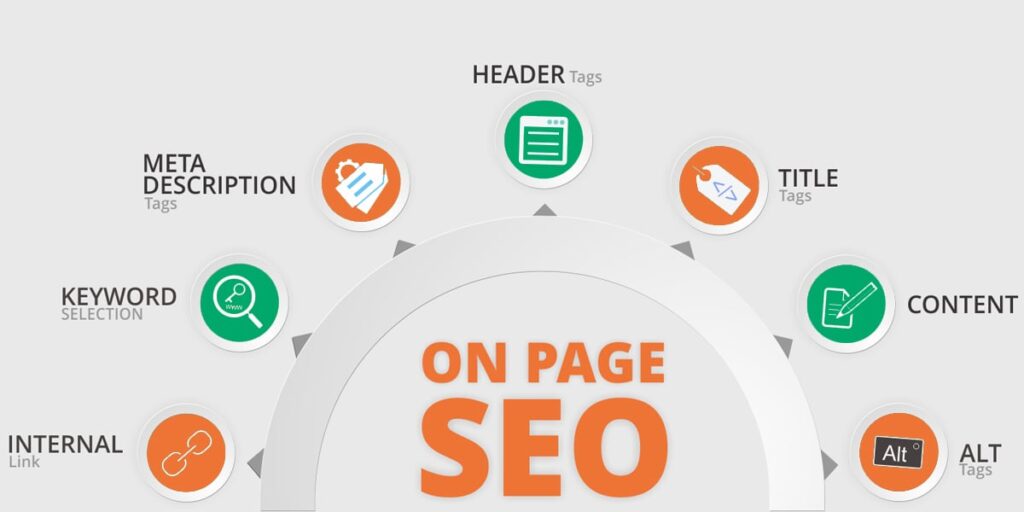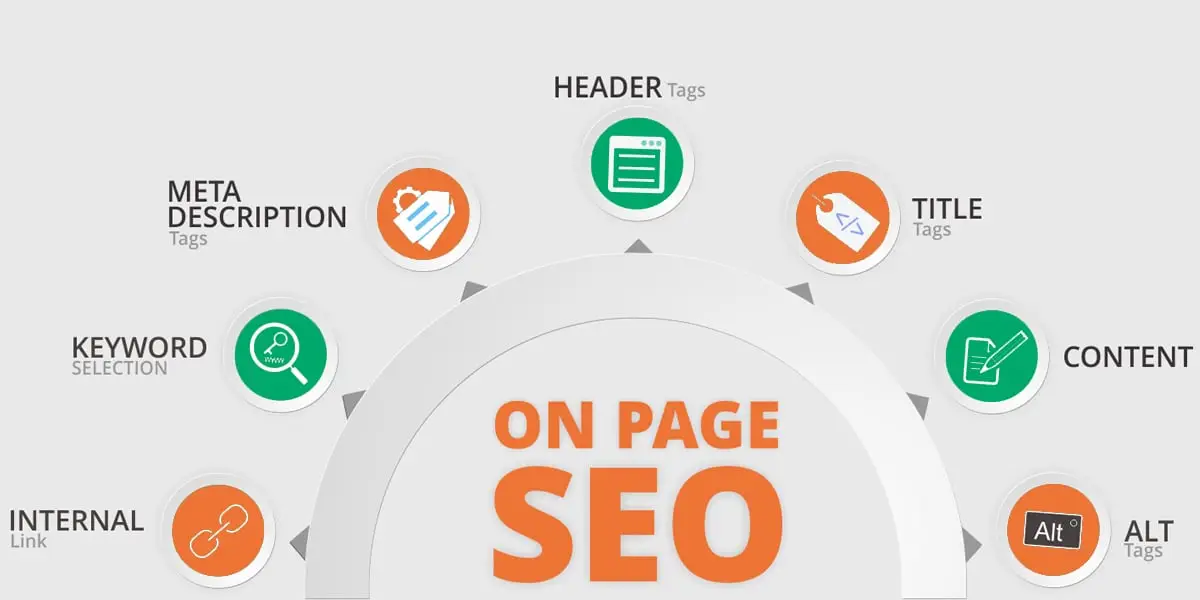Slug: ultimate-guide-on-page-seo-techniques-tips-2025
Introduction
On-page SEO is the backbone of any successful digital marketing strategy. Unlike technical or off-page SEO, which focuses on backend fixes or external links, on-page SEO revolves around optimizing elements directly on your website to improve search rankings and user experience. In this guide, you’ll learn actionable on-page SEO techniques, how to implement them using tools like Yoast SEO, and why they matter in 2025.
Key Takeaway: On-page SEO is about making your content and website structure search-engine-friendly while delivering value to users. Let’s dive in.
1. What Is On-Page SEO?
On-page SEO (or on-site SEO) refers to optimizing elements within your control on a webpage to rank higher and attract relevant traffic. This includes:
- Title tags and meta descriptions.
- Headers (H1, H2, H3).
- Content quality and keyword usage.
- Internal linking.
- URL structure.
- Image optimization.
Why It Matters: Google’s algorithms prioritize pages that align with user intent. Proper on-page SEO signals relevance, authority, and usability, helping your content stand out.

2. Ensure Your Site is Crawlable for Search Engines
Search engines use bots to crawl your website by following links to discover content. A well-structured internal linking system helps search engines understand the most important pages on your site.
Using the Robots.txt File
The robots.txt file directs search engine bots on how to navigate your site. While this is a powerful tool, improper use can prevent search engines from accessing essential parts of your website, such as CSS and JavaScript files. These files define your site’s appearance and functionality. If they are blocked, search engines may struggle to render and index your site correctly.
Best Practices:
- Allow bots to crawl critical pages like your homepage, blog posts, and product pages.
- Block unnecessary pages like admin or login pages.
Yoast Tip: Use Yoast SEO to manage your robots.txt file and ensure it’s configured correctly.
The Meta Robots Tag
The meta robots tag is found in a page’s source code, within the head section. It provides instructions to search engines on how to handle a specific page.
With the Yoast SEO plugin, you can easily manage these settings. If you want a page to be crawled but not displayed in search results, you can set it to noindex. Similarly, you can prevent search engines from following links on a page by using the nofollow option.
3. Avoid Dead Links (404 Errors) using on-page SEO
A slow website can be frustrating, but encountering a 404 error page is even worse. Broken links disrupt user experience and harm your SEO.
Search engines follow every link they find, even hidden ones. That means they may discover more dead links than actual visitors.
How to Fix 404 Errors using On-Page SEO :
- Redirect URLs whenever you delete or move a page.
- Use 301 redirects to send users to a relevant page that replaces the old content.
Yoast Tip: With Yoast SEO Premium, you can set up 301 redirects easily, without needing a developer.
4. Prevent Duplicate Content Issues
Duplicate content confuses search engines. If multiple pages have identical content, search engines struggle to determine which one to rank, potentially lowering your overall rankings.
Using Canonical URLs
A canonical URL tells search engines which version of a page to index and rank.
With Yoast SEO, you can easily set a canonical URL for any page. The plugin also automatically adds self-referencing canonical tags to your pages, reducing the risk of duplicate content issues.
5. Title Tags: Your First Impression
Your title tag is the clickable headline in search results. It’s critical for both SEO and user engagement.
Best Practices for Title Tags
- Keep It Under 60 Characters: Yoast SEO’s preview tool shows how your title appears in SERPs. Avoid truncation.
- Include Primary Keywords: Place your target keyword near the front (e.g., “On-Page SEO Guide: 2025 Tips for Higher Rankings”).
- Add Branding (Optional): Include your brand name at the end if space allows.
- Avoid Keyword Stuffing: Focus on readability.
Yoast Tip: Use Yoast’s title tag analysis to check keyword placement and length.
6. Meta Descriptions: Persuasive Previews
Meta descriptions summarize your page’s content in SERPs. While not a direct ranking factor, they influence click-through rates (CTR).
Writing Effective Meta Descriptions
- Length: Aim for 150–160 characters.
- Include Keywords: Google may bold matching search terms, grabbing attention.
- Add a CTA: Use phrases like “Learn how…” or “Discover tips…” to encourage clicks.
- Match User Intent: Align with the search query’s purpose (e.g., informational vs. transactional).
Example:
“Master on-page SEO in 2025 with this step-by-step guide. Optimize titles, content, and images using Yoast SEO for higher rankings.”
Yoast Tip: Yoast’s snippet editor highlights optimal meta description length and keyword usage.
7. Header Tags: Structure for Readability and SEO
Headers (H1, H2, H3) break content into sections, improving readability and helping search engines understand your page’s hierarchy.
Optimizing Headers
- Use One H1 Tag Per Page: This should mirror your title tag.
- Incorporate Keywords Naturally: Include variations in H2s and H3s (e.g., “On-Page SEO Best Practices” or “How to Optimize Images for SEO”).
- Avoid Skipping Header Levels: Follow the order H1 > H2 > H3.
Yoast Tip: Yoast’s content analysis checks header structure and keyword distribution.
8. Content Optimization: Quality Over Quantity
High-quality content is the #1 ranking factor. Google’s Helpful Content Update prioritizes pages that satisfy user intent.
Steps to Optimize Content
- Target a Primary Keyword: Use tools like SEMrush or Ahrefs to find low-competition, high-volume keywords.
- Cover the Topic Thoroughly: Answer related questions (e.g., “What is on-page SEO?” or “Why are internal links important?”).
- Use Transitional Phrases: Improve flow with words like “additionally,” “for example,” and “however.”
- Optimize Readability:
- Short paragraphs (2–3 sentences).
- Bullet points for lists.
- Active voice (e.g., “Optimize your titles” instead of “Titles should be optimized”).
Yoast Tip: Yoast’s readability analysis scores your content’s readability and suggests improvements.
9. Internal Linking: Guide Users and Search Engines
Internal links connect related pages on your site, distributing authority and keeping users engaged.
Best Practices
- Link to Relevant Pages: Use descriptive anchor text (e.g., “Learn about technical SEO” instead of “Click here”).
- Prioritize Top Content: Link to cornerstone articles or high-priority pages.
- Avoid Overlinking: 3–5 internal links per 1,000 words is a safe range.
Yoast Tip: Yoast’s internal linking tool suggests relevant posts to link to as you write.
10. URL Structure: Keep It Simple
A clean URL structure improves user experience and SEO.
Optimizing URLs
- Use Hyphens to Separate Words:
yourwebsite.com/on-page-seo-guide - Include Keywords: Avoid generic URLs like
yourwebsite.com/page123. - Keep It Short: Remove unnecessary words (e.g., “and,” “the”).
Yoast Tip: Yoast automatically generates SEO-friendly URLs based on your post title.
11. Image Optimization: Speed and Accessibility
Images enhance content but can slow down your site if not optimized.
Steps to Optimize Images
- Compress Files: Use tools like TinyPNG or ShortPixel.
- Add Descriptive Alt Text: Include keywords (e.g., “On-page SEO checklist on a laptop”).
- Use Descriptive Filenames:
on-page-seo-checklist.jpginstead ofIMG_1234.jpg. - Lazy Load Images: Delay offscreen images from loading until users scroll.
Yoast Tip: Yoast’s image SEO check reminds you to add alt text and compress files.
12. Mobile-Friendliness: Non-Negotiable in 2025
Google uses mobile-first indexing, meaning it crawls and ranks pages based on their mobile version.
How to Optimize for Mobile
- Responsive Design: Ensure your site adapts to all screen sizes.
- Test Page Speed: Use Google PageSpeed Insights.
- Avoid Intrusive Pop-Ups: They harm user experience on mobile.
Yoast Tip: Yoast’s mobile preview shows how your content appears on smaller screens.
13. Page Speed: The Need for Speed
Slow pages increase bounce rates and hurt rankings.
Improving Load Times
- Enable Caching: Plugins like WP Rocket store static versions of your pages.
- Minify CSS/JavaScript: Reduce file sizes.
- Use a CDN: Serve images from servers closer to users.
Yoast Tip: Yoast integrates with speed optimization plugins to streamline fixes.
14. Schema Markup: Stand Out in SERPs
Schema markup helps search engines understand your content better, often leading to rich snippets.
Common Schema Types
- Article: For blog posts.
- FAQ: For question-and-answer content.
- How-To: For step-by-step guides.
Yoast Tip: Yoast SEO automatically adds basic schema markup to your pages.
15. User Engagement: Reduce Bounce Rates
Engaging content keeps visitors on your site longer, signaling quality to Google.
Tips to Boost Engagement
- Add Videos or Infographics: Visuals break up text.
- Include a Table of Contents: Helps users navigate long posts.
- End with a CTA: Ask readers to comment, share, or explore related posts.
16. On-Page SEO Checklist
Use this checklist to audit your pages:
- Title tag includes primary keyword On-Page SEO and is under 60 characters.
- Meta description has a CTA and target keyword.
- Headers (H1, H2, H3) are properly structured.
- Content is comprehensive and uses active voice.
- Internal links connect to relevant pages.
- URLs are short and keyword-rich.
- Images are compressed and have alt text.
- Page loads in under 3 seconds.
- Schema markup is implemented.
- Mobile-friendly design.
17. Common On-Page SEO Mistakes to Avoid
- Ignoring Mobile Optimization: 58% of website traffic comes from mobile.
- Keyword Stuffing: Focus on natural language.
- Duplicate Content: Use canonical tags if necessary.
- Skipping Alt Text: Hurts accessibility and image SEO.
18. Tools for On-Page SEO
- Yoast SEO: Analyze titles, meta descriptions, and readability.
- Google Search Console: Monitor rankings and crawl errors.
- Ahrefs/SEMrush: Track keywords and competitors.
- Screaming Frog: Audit technical SEO issues.
Conclusion
On-page SEO isn’t a one-time task but an ongoing process. By optimizing titles, content, images, and technical elements, you’ll create a website that ranks higher, engages users, and drives conversions. Tools like Yoast SEO simplify the process, offering real-time feedback to keep your pages search-engine-friendly.
Final Tip: Regularly audit your content using the checklist above, and stay updated with Google’s algorithm changes to maintain your competitive edge.
